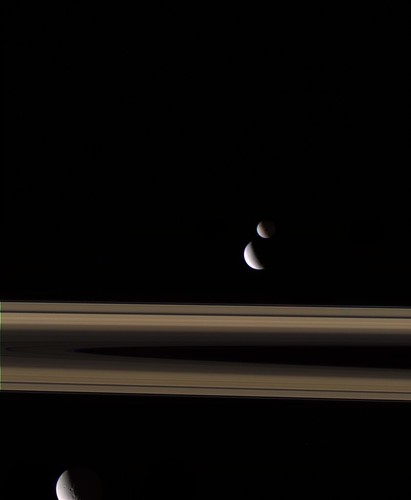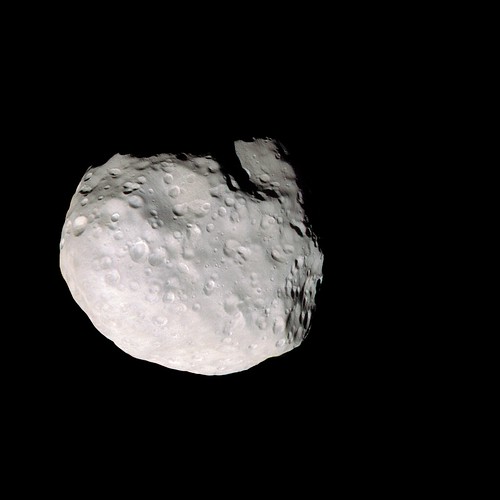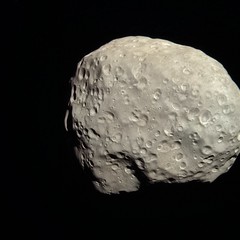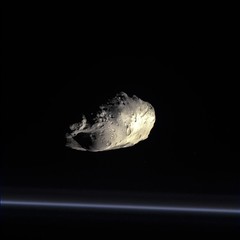Details for this revolution are available here
This is the orbit I've been looking forward to for some time as it affords us a closer glimpse at Atlas, Prometheus and Epimetheus.
In fact, Cassini approaches the latter two at a closer range than it will for the remainder of the mission, and observations are planned for both, as well as Atlas.
This, despite having to turn the spacecraft and use the high-gain antenna as a shield during ring-plane crossing to avoid any possible collisions with debris in the ring-plane.
This must have been an extra-specially complicated sequence of observations to plan, as it all happens at or around periapse.
I'm really looking forward to another view of Atlas particularly - can't wait!!!
Jase
Full Version: Rev 227
Unmanned Spaceflight.com > Outer Solar System > Saturn > Cassini Huygens > Cassini's ongoing mission and raw images
Here's an RGB composite of astrometric observations of Mimas, Enceladus, and Tethys from December 3.

Moon Trio - Rev 227 by Justin Cowart, on Flickr

Moon Trio - Rev 227 by Justin Cowart, on Flickr
Flying saucer ?
http://saturn.jpl.nasa.gov/multimedia/imag...2/N00251477.jpg
Is it just the play of light and shadow, or really Atlas is extremely flat ?
http://saturn.jpl.nasa.gov/multimedia/imag...2/N00251477.jpg
Is it just the play of light and shadow, or really Atlas is extremely flat ?
Very nice Justin, thanks for that!
Cassini-Huygens has to be in the top five UMSF missions ever in terms of scientific return, ingenuity, and sheer beauty.
Cassini-Huygens has to be in the top five UMSF missions ever in terms of scientific return, ingenuity, and sheer beauty.
Flying saucer ?
http://saturn.jpl.nasa.gov/multimedia/imag...2/N00251477.jpg
Is it just the play of light and shadow, or really Atlas is extremely flat ?
http://saturn.jpl.nasa.gov/multimedia/imag...2/N00251477.jpg
Is it just the play of light and shadow, or really Atlas is extremely flat ?
I think Atlas really is that shape- a kernel of fairly solid spherical material with accretions of candy-floss icy-stuff around the equator.
Prometheus close-ups now available:
And Epimetheus....
And the rings too... Just marvellous!
Feel so privileged to have this ringside seat - sat on my backside at home, not having contributed anything meaningful to this mission yet able to access in almost real-time these stunning images from half-way across the solar-system.
Fantastic!
Jase
Fantastic!
Jase
Gosh, and I thought that Methone was bizarre. Even though it should not be a surprise that orbiting in such a dusty environment blankets a satellite in dust, but to such an extent and depth...
Flying saucer ?
http://saturn.jpl.nasa.gov/multimedia/imag...2/N00251477.jpg
Is it just the play of light and shadow, or really Atlas is extremely flat ?
http://saturn.jpl.nasa.gov/multimedia/imag...2/N00251477.jpg
Is it just the play of light and shadow, or really Atlas is extremely flat ?
It's a combination of both. Atlas has a small, roughly spheroidal body at the center, but it's accumulated a thick pancake of ring material along its equator extending out to around the moon's Roche limit. It reaches out far enough that it's blocking light from falling on the moon's southern hemisphere since it's getting close to the southern winter solstice.
A couple pictures of Epimetheus, IIRC these will be the best of the mission. It's suprisingly Phobos-like - smooth, old terrain peppered by a lot of smaller fresh craters. It's even got a few grooves here and there! It's also interesting to see some of the darker patches in the bottom of craters on the left side. Sort of looks like layering, although other image sets of the moon make it look more like loose dust that's moved around the moon.


And one of Prometheus around closest approach. I'm not sure if it's just a lighting effect, but it looks like many of the craters are surrounded by dark rings.

Two gif's of the mutual events of Mimas and Enceladus on December 3.
Very nice renderings everyone!
Incidentally, it looks as though the pointing for the Atlas sequence was fractionally off as it falls right on the edge of the FoV in the images.
Understandable though as its orbit is somewhat unpredictable. From Wikipedia:
"Atlas is significantly perturbed by Prometheus and to a lesser degree by Pandora, leading to excursions in longitude of up to 600 km (~0.25°) away from the precessing Keplerian orbit with a rough period of about 3 years. Since the orbits of Prometheus and Pandora are chaotic, it is suspected that Atlas's may be as well.[1]"
Doubtless Aegaeon's imaging sequence on the next orbit has been designed to take account of that moon's orbital uncertainty. Add to that it's a very close, fairly fast flyby, of a moon that has a low albedo, and is tiny even compared to Atlas...
This shows the wisdom of the dozens (hundreds?) of astrometric observations of the small moons the Cassini team has written into the sequences on almost every revolution in recent years, refining their orbits to the finest degree possible.
Incidentally, it looks as though the pointing for the Atlas sequence was fractionally off as it falls right on the edge of the FoV in the images.
Understandable though as its orbit is somewhat unpredictable. From Wikipedia:
"Atlas is significantly perturbed by Prometheus and to a lesser degree by Pandora, leading to excursions in longitude of up to 600 km (~0.25°) away from the precessing Keplerian orbit with a rough period of about 3 years. Since the orbits of Prometheus and Pandora are chaotic, it is suspected that Atlas's may be as well.[1]"
Doubtless Aegaeon's imaging sequence on the next orbit has been designed to take account of that moon's orbital uncertainty. Add to that it's a very close, fairly fast flyby, of a moon that has a low albedo, and is tiny even compared to Atlas...
This shows the wisdom of the dozens (hundreds?) of astrometric observations of the small moons the Cassini team has written into the sequences on almost every revolution in recent years, refining their orbits to the finest degree possible.
Doubtless Aegaeon's imaging sequence on the next orbit has been designed to take account of that moon's orbital uncertainty. Add to that it's a very close, fairly fast flyby, of a moon that has a low albedo, and is tiny even compared to Atlas...
Yep, the observation is basically a series of two-frame mosaics. Should help to ensure that Aegaeon is in the FOV.
A contrast stretch shows even more grooves on Epimetheus than show up at first glance.
Phil
Click to view attachment
Phil
Click to view attachment
I've added artificial color to the WAC clear-filtered frame of Epimetheus, approximating the view a human might have from the same vantage point.
Click to view attachment
Click to view attachment
Has anybody else tried their hand at the Atlas images? Here are my quick-and-dirty versions, but I know others can do better.
Eli's had a crack at Atlas already, Emily:
http://www.unmannedspaceflight.com/index.p...st&p=228437
This is my attempt at the Prometheus obs with a semi-automated method of removing the digital smuts:
Click to view attachment
http://www.unmannedspaceflight.com/index.p...st&p=228437
This is my attempt at the Prometheus obs with a semi-automated method of removing the digital smuts:
Click to view attachment
Up late working on that one Ian!
Very nice.
Very nice.
Thanks Jase! Yeah, I work best after the Moon rises it seems .... 
Looking at the PDS data for this medium-range flyby of Atlas, I realized a number of frames at the start of the sequence were taken against the backdrop of Saturn's night-side. Thanks to the faint illumination of the cloud decks with ring-shine, an extreme contrast stretch of the images reveals the moon's equatorial bulge and southern hemisphere in profile.
Click to view attachment
Click to view attachment
Click to view attachment
Click to view attachment
Great catch!
Nice work!
I've added artificial color to the WAC clear-filtered frame of Epimetheus, approximating the view a human might have from the same vantage point.
Click to view attachment
Click to view attachment
At first I was really taken aback...Looks like Phobos 2 image from VSK in 1988
This is a "lo-fi" version of our main content. To view the full version with more information, formatting and images, please click here.





